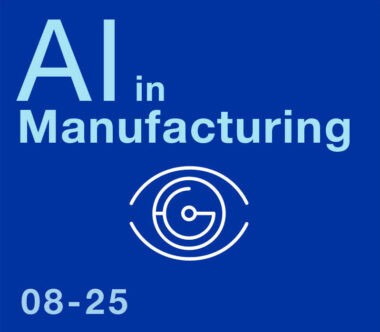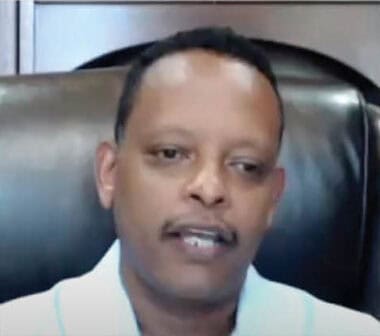Dialogue: At Merck, It Takes a Digital Village
From shared purpose to tech-powered teams, MLC’s 2025 Manufacturing Leader of the Year, Merck’s Besu Alemayehu, explains what it takes to drive digital transformation.

JEFF PUMA: Hello and welcome to the Manufacturing Leadership Journal Executive Dialogue for August 2025. I’m Jeff Puma, content director for the Manufacturing Leadership Council. I’m excited to welcome Besu Alemayehu as our guest today.
In addition to his role as the senior vice president for digital manufacturing and supply at Merck, Besu was recently recognized at the 2025 Manufacturing Leadership Awards in the Digital Transformation Leadership category. And what’s more, he was named the 2025 Manufacturing Leader of the Year, which is the top individual honor handed out by the Manufacturing Leadership Council.
Besu, congratulations and thanks for joining me.
BESU ALEMAYEHU: Thank you. Thank you for having me.
JP: I want to start by taking us back a few weeks to the Manufacturing Leadership Awards Gala.
You didn’t know you were going to win, but I did. And from where I was sitting on sort of the side of the stage in the front, I could see you, and as I was watching NAM CEO Jay Timmons, he was describing the recipient of the award. He was sharing some really nice things that that person’s colleagues had said about him, but he hadn’t said your name yet. When he mentioned that the winner was born in Ethiopia it became obvious that he was talking about you, and I could see a big smile on your face. I could see the people around you start congratulating you. Can you take us back to that moment? What was it like to hear your name read along with all those other accolades that were mentioned in the lead up to the announcement?
BA: Thank you. It was surreal. A lot of things overwhelmed my mind for a few seconds. It took me a few seconds to realize the gravity of the recognition both personally and professionally. So a lot of things went into my mind.
The first thing which came to my mind was my mother, obviously. I was just talking to my son. I only have one son. I was excited about the digital transformation recognition, so I was sharing with family when I heard the Ethiopian introduction, and that’s when reality set in.
But it’s a very humbling moment. As I always say, “it takes a village.” It really did in the Merck case and it’s a team’s effort. It’s very humbling to represent the team and accept this award and recognition on their behalf.
But from humble beginnings in Ethiopia to being in a role which is impactful in saving lives and improving lives is one of rare opportunities in life. You need to recognize and acknowledge and accept the gravity of the work we’re doing in the life sciences industry.
So it was surreal, overwhelming.
JP: That’s great. And you mentioned in your speech, and just right now in your answer that “it takes a village,” and I want to talk about the team that you lead. It’s a fairly new team. It came into existence about two years ago if I understand correctly. How did this team get started? And how did you decide where to focus first when looking to create value?
BA: When I first joined Merck, and when the task was given to me, I spent the initial few weeks and months really listening. Coming into a very established organization and understanding the problem statement and realizing what it takes to get us from where we are to the destination was quite a task. So I spent some time, and it was obvious to me that there are certain things which needed to come together.
One is the clarity of strategy. Two was the partnership across the ecosystem. And three was the right sized team with the right skillsets in place was a must.
Once we have clarity of a strategy and clarity of that roadmap—the lighthouse, was what we said—then we need to bring in a diverse team. It’s not only technology. It needs to be a diverse team in skillsets. So we decided to combine it, but more importantly, one-third of that team should come from the outside with both technical and business expertise.
So that’s really what set us up for success. And this is really their success. What they were able to drive because of that diversity in thought, diversity in skills, diversity in backgrounds, and diversity in the way they came up through the ladders in their own journey really contributed to the success of this program. That was the defining moment for our success, to be quite frank.

The technology can be a fit for purpose. But really winning hearts and minds and aligning them behind one objective, one goal, one hill to conquer was the monumental task of this job.
JP: You mentioned that it is about people and not just technology. How did you get these individuals with this diverse background and these diverse thoughts, how did you get them to adopt a digital-first mindset?
BA: It was not easy. Technology is not a challenge once you get to know what you really need to do. The capabilities are out there. The technology can be a fit for purpose.
But really winning hearts and minds and aligning them behind one objective, one goal, one hill to conquer was the monumental task of this job.
So what did we do? First define that end goal. What that north star should look like.
And then define the paths and along the way bring both the technology experts, the business process experts, the science experts together—not only to deliver it, but to define the problem statement together, define the solution, design the solution together, deliver the solution together, and then eventually, run that that business with that capability—combined capability. Technology as not an enabler, but as part of the operation and part of the day-to-day.
So really aligning them behind that common goal, common objective and common hill to conquer, as I always say, is what really drove us to success, and what helped us achieve what we set out to do.
It was really that clarity of purpose and our job—our industry—luckily has clarity of purpose. Everyone in that team has someone who can benefit from the work we’re doing: distant relative, close relative, family member, friends. It was a purpose-driven initiative and aligning them behind that common objective was the defining moment for us.
And we still do that. We identified about 14 areas of opportunity for transformational opportunities, and the opportunity leaders always come from the subject matter expertise. And then they come under the one umbrella as one team, delivering one objective, with one team mindset and one objective. So really, the people in the team.
JP: What advice would you give to other manufacturing leaders as they try to align strategy with technology?
BA: I think the first thing is don’t think of those two as two separate and distinctly independent components of the business. They are one in the same in today’s day and age. I always joke about with my colleagues, my friends at work and the executives. I always say, “If you really want to test the importance of technology, I dare you to close it for a month and see if the business can run and if you can deliver on your objectives.”
I think that mindset that technology is no longer a support function, no longer a nice to have. It’s a must have. Starting with that mindset, is the first step towards that objective of taking it as a core component of your transformation and enablement.
Two, if you want to go further, bring the village together. If you want to be tactical, you can deliver a tactical solution. But in today’s day and age, there is no one component, one vertical which can deliver an end-to-end business transformation or business value.
So what do you do?
You bring that entire village together and then make them part of the solution and part of every step of the way as we go through this delivery and exercise. It’s really an important component to instill in the organization psyche and the organization’s culture.
And having a seat at the table. One of the things we did was the digital partners of the business areas, they are core members of their respective leadership teams. There’s no longer, “throw it over the fence.”
They are a core part of the strategy, core part of the execution, core part of the continuous improvement.
It’s really important to integrate all of those as one versus multiple parallels.

You bring that entire village together and then make them part of the solution and part of every step of the way as we go through this delivery and exercise.
JP: Let’s dive a little bit more into that. One of the most frequent topics and hurdles that we always hear about at the MLC is collaborating across functions and removing silos. How have you been able to foster collaboration that’s effective and leads to those positive outcomes?
BA: Well the first thing is knowing your audience, knowing the business problems and the problem statements. But more importantly, knowing your business as equal, if not more than your partners in the business, so that you can articulate the values based on outcomes—not on projects, not on cost but outcomes.
And once you start to show what good could look like in this focused outcomes-driven space, it becomes easier.
But usually change is hard especially for a successful company in our industries, multiple industries. If you have been successful for 100 years, why would you change today? So articulating that call for change, call for transformation is really, really important.
Second is really building that support. In our case—from the board to the CEO, down to the divisional leaders, to the CIDO, including his leadership team—we are all aligned and mandated to drive that change. To use [Merck CEO] Rob Davis’s terms: business is good, we’re doing really well, but everything has to change, because what got us here is not going to get us to the next few decades.
And the pipeline is the most promising pipeline with real impact to people, society and mankind at large. So really aligning and instilling that and showing that support spine up and down the food chain is really important, because it sends the message, it sends the tone, and it brings people and encourages people to speak up. And they are closest to the operations, so we do that.
And then, last but not least, is encouraging that speaking truth to power culture, that opened up culture, right? Look at what are the problem statements? What are the problem areas? What do you see as a pitfall for this initiative? Because they are the closest to the heart of it. And providing and creating that safe space where people can come and speak up, come and throw their ideas and challenge us on a continuous state, in a most constructive way. We’ll always open the doors.
You’ll be amazed, for this transformation—which has billions attached to it—we haven’t used any of the big name consulting firms. We really crowdsourced these opportunities, and we picked the 14 of them based on impact. And each and every one of them is returning value to the organization. So when you really unleash that power, when you bring that village together again and empower them. Create that safe space. Encourage a dialogue and healthy tension in the wire to encourage thinking outside of the box—there is no replacement for that in my mind.
JP: You’ve unleashed the power. Looking back at it as you think about the digital transformation to date, what surprised you most, either good or bad? And how did you adapt or change things in order to take advantage of the good things and overcome the bad?
BA: What surprised me the most, positively, was the packed power of Merck’s talent. The people in the organization. How much they know. How much dedication there is in the system, and the belief in the mission of Merck and the work they do. That was really powerful for me.

We think we know it all when we are in the industry for 30 years, but this [next] generation went to school with no textbooks. Their way of thinking about digital and technology and enablement is incredible.
And what surprised me the most is again, the people, the strong resistance for change. But once you really understand the strengths and the opportunity, and you manage to create that bond between the two—the strength and the opportunity—and show that, as I always say, in simple kindergarten ways, so that anyone can digest it because it’s a multifaceted transformation. What it means to supply chain to quality, to the engineering is very different. So developing that skill and that simplicity in the system to show in such a simple and understandable way was a big challenge. Once we were able to close that gap between the two, it was an easier journey to the end.
And the third one—which really surprised me—was once people understood, all of that resistance turned into a demand. A demand we’re not able to satisfy. We created a monster in a way, in the system. The hunger for more data, interconnectivity, insights to run our business that I didn’t expect. We’re working so hard to penetrate through that resistance, and once we passed that what we didn’t anticipate was how fast we needed to go. That was a big miss on our part, but not in a bad way, in a good way.
JP: I have two more questions, and I want to shift to thinking about the future for these questions. So how should current leaders go about cultivating and nurturing the next generation of future leaders?
BA: I think it’s amazing, this new generation of leaders, engineers, manufacturing experts. How they think is very different. How they are wired is very different. How they are formed and educated is very different. The insights they bring into an established organization—manufacturing is an industry with a very long history—as they come into that fold, I think we need to receive them with an open mind and be open to listen. Because what they see is amazing, and how simply they think and how quickly they can bring an impact to the organization is really important. For me, encouraging them to speak up and encouraging the innovative tools and creating that mechanism that can hit the system so that we can benefit from these great ideas, innovative thinking, and outside the box thinking is really important. So encouraging coaching and mentoring is really important.
But, more importantly, I tell my colleagues, “Be humble.” We think we know it all when we are in the industry for 30 years, but this generation went to school with no textbooks. Their way of thinking about digital and technology and enablement is incredible. Quite a few of my young employees don’t even have checkbooks anymore. They are natively digital and bringing them to our industry and forcing them to go back to paper when they don’t even know how to legibly write certain things, is not very constructive. So be open, be humble, encourage that new way of thinking, new way of looking at things, because the future is very different than what has been for the last 30 or 40 years. The future is digital. The future is native digital, integrated digital.
And with AI coming to the mix, now insights and decision making on the fly is going to be a basic requirement of any good business in the future—any good manufacturing in our case.
So being open, being humble and continuously coaching and mentoring this new generation of leaders and engineers to continue to think innovatively and challenge the status quo and dare to speak up is really what should set us apart in the future.
JP: So, speaking of the future, what about the digital manufacturing future really makes you excited? Maybe not just at Merck, but across all of industry.
BA: At the MLC [Rethink], I was fascinated by some of the use case presented. How the industry is thinking outside of the box. How the industry is innovating with these new capabilities coming up.

When I think about the future of manufacturing, all I think about is that fully automated, fully integrated, fully digitally enabled, and data savvy industries are what I see across the board.
When I think about the future of manufacturing, all I think about is that fully automated, fully integrated, fully digitally enabled, and data savvy industries are what I see across the board. From the way we design our molecules in our case, or the cars, or the planes, or the robotics, to how we deliver, how we draw insights from every data, and how we predictably intervene and continuously improve our designs by getting that feedback loop mechanism into our system.
I think the future is digital and manufacturing could benefit a great deal, because if you look at the cost of any production, manufacturing and supply are a big component.
And if you look at the opportunities today in our space. They revolve around those 2-3 areas, between logistics and post-market data and continuous improvement of your product specifications or molecule improvements. It’s all digital, it’s all in the manufacturing space, and I’m super excited, not only for me and my generation, but for the coming generations because they are bound to do great things because it’s an opportunity-rich space. And within that space there are a lot of great innovations to be done. And I can see it. It’s coming. It’s coming and it’s coming fast and furious. So, we need to get ready for it.
JP: Excellent. Well, thank you for your answers and congrats, again, on being named the 2025 Manufacturing Leader of the Year.
We’re excited to hopefully continue our conversations with you, and perhaps bring you back for Rethink in 2026 if you’re available. You have a wealth of information to share some incredible examples. And a great mindset of how to deal with your teams and with digital transformation, and bring it all together with people and technology and organizational change. Thank you so much for being here and sharing these insights.
BA: No, thank you, thank you. I look forward to the next Rethink. Thank you very much. M
Portions of this interview have been edited for clarity and length.
About the Interviewer:

Jeff Puma is content director for the NAM’s Manufacturing Leadership Council